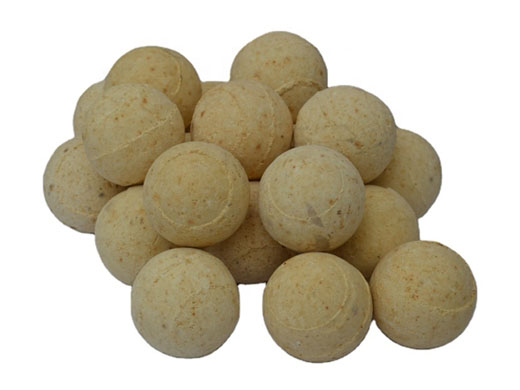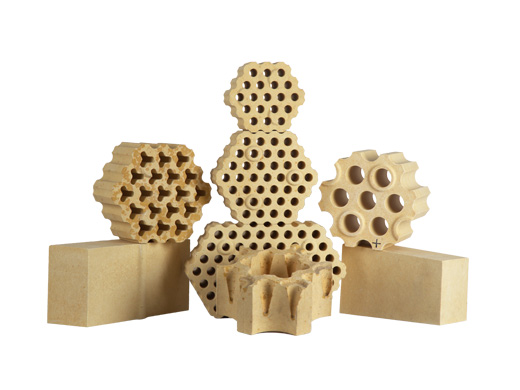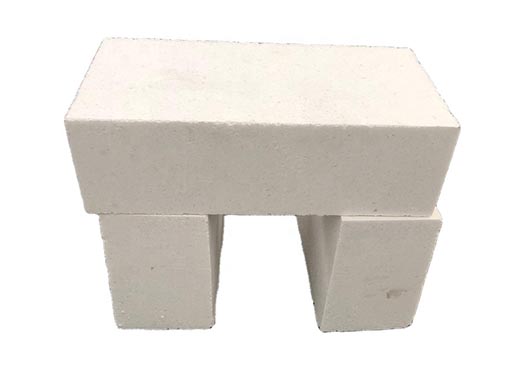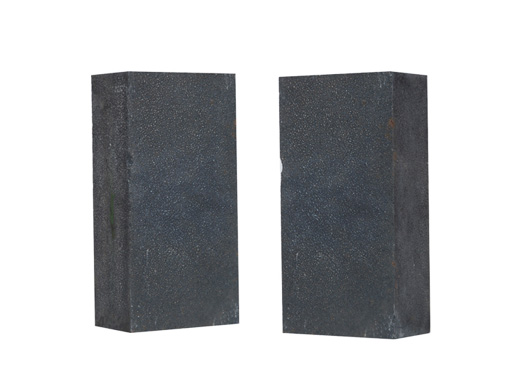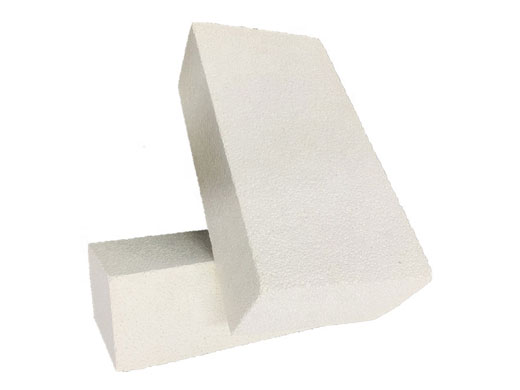Properties of silicon nitride and its application in refractories
Industry news | Refractory Wiki | Refractory news | Enterprise news |Silicon nitride (Si3N4) is a synthetic refractory material with excellent wear resistance, high-temperature resistance, and corrosion resistance. In its application in refractory materials, it mainly appears in the form of a bound phase.
1.Crystal Structure of Silicon Nitride
Si3N4 has two crystal structures: α-Si3N4, which is a granular crystalline structure, and β-Si3N4, which is a needle-like crystalline structure (see Figure 1). Both structures are three-dimensional spatial networks formed by sharing corners of [SN4] tetrahedra and belong to the hexagonal crystal system. The difference lies in the arrangement order of the [SiN4] tetrahedral layers. The β-phase is formed by overlapping six symmetrical hexagonal layers composed of [SN4] tetrahedra along the c-axis direction, while the α-phase is formed by the overlapping of two layers of deformed and different non-hexagonal layers. The α-phase can solidly dissolve oxygen within its crystal structure, and it has a higher internal strain and free energy compared to the β-phase. From a thermodynamic perspective, the β-phase is more stable at higher temperatures. The α-phase has lower symmetry and is prone to form. At approximately 1500℃, the α-phase undergoes a reconstructive transformation irreversibly and converts into the β-phase. Certain process conditions and the existence of certain impurities favor the transformation of the α-phase to the β-phase. α-Si3N4 forms below 1350℃, while β-Si3N4 can be directly synthesized at temperatures above 1500℃.

(a) Atomic arrangement of α-Si3N4; (b) Atomic arrangement of β-Si3N4
Figure 1 Atomic arrangement of α-Si3N4 and β-Si3N4
2.Basic Properties of Silicon Nitride
The molecular formula of silicon nitride is Si3N4, with Si accounting for 60.06% and N accounting for 39.94%. Si and N are strongly bonded by covalent bonds (with only 30% being ionic bonding), resulting in high hardness (Mohs hardness of 9) and high melting point of Si3N4, making its structure stable.
Table 1 Lattice constants and density of Si3N4.

Table 2 Basic Properties of Silicon Nitride

The lattice constants and densities of Si3N4 are listed in Table 1. From the data in the table, it can be seen that there is not much difference in lattice constant A between the α phase and the β phase, while the lattice constant C of the α phase is approximately twice that of the β phase. The densities of these two phases are almost equal, so they do not cause significant changes in volume during phase transition. Table 2 shows the basic properties of silicon nitride.
In the silicon nitride crystal, Si-N bonds are mainly covalent bonds, which have high bond strength. Therefore, it has a large elastic modulus (4.7×105 kg/cm2). It has a low coefficient of thermal expansion and a high thermal conductivity, making it resistant to thermal stress and good in thermal shock resistance. It has toughness, high mechanical strength at high temperatures, and small deformation at high temperatures. (For silicon nitride ceramics with a density of 2.5 g/cm3, at a temperature of 1200℃ for 1000 hours and a load of 23×7 kg/cm2, the high-temperature deformation is 0.5%). It has strong corrosion resistance. It is not corroded by many metals and has good oxidation resistance and electrical insulation properties due to the formation of a silicon dioxide layer.
Silicon nitride does not have a melting point. It sublimates and decomposes under normal pressure at around 1900℃, with a specific heat of 711.8 J/kg·℃. The microhardness of the α phase and the β phase is 10-16 GPa and 24.5-32.65 GPa, respectively. Since it is a strongly covalent compound, there is no liquid phase generated below its decomposition temperature (approximately 1900℃). Therefore, silicon nitride materials need to be sintered with the help of oxide additives. The main oxide materials that promote sintering are Y2O3, Al2O3, etc., and the amount added can reach 20%. The reaction principle is that the SiO2 oxide film formed on the surface of silicon nitride particles interacts with the added oxide to generate a liquid phase, which penetrates into the grain boundaries to ensure high diffusion capability during material migration.
3.Chemical Stability of Silicon Nitride
Si3N4 belongs to thermodynamically stable compounds. Silicon nitride ceramics can be used in an oxidizing atmosphere up to 1400℃, and in a neutral or reducing atmosphere, it can be used up to 1850℃. In fact, Si3N4 undergoes oxidation reaction above 800℃:
Si3N4 + 3O2 = 3SiO2 + N2↑(1)
The sample gains weight, gradually forming a dense silica protective layer on the surface, preventing further oxidation of Si3N4. It is not until above 1600℃ that the weight gain becomes more pronounced. However, in a humid atmosphere, Si3N4 is particularly prone to oxidation. Oxidation begins at around 200℃, and the rate is about twice as fast as in dry air. The activation energy for the oxidation of Si3N4 powder in water vapor is significantly lower than that in oxygen and air. The reason is that water vapor can react with Si3N4 through the amorphous SiO2 film:
Si3N4 + 6H2O = 3SiO2 + NH3↑(2)
Silicon nitride is stable against most metal solutions, not corroded or infiltrated, such as Al, Sn, Pb, Bi, Ga, Zn, Cd, Au, Ag, etc. However, it is only immune to corrosion by Cu solutions in a vacuum or inert atmosphere. It has weak reactions with Mg and can be wetted and slightly corroded by silicon solutions. Transition metal solutions strongly wet Si3N4, form silicides with Si, and rapidly decompose silicon nitride, while releasing N2. Si3N4 is stable in alloy solutions such as brass, hard aluminum, and nickel-silver, and it also has good corrosion resistance to cast iron and medium-carbon steel. However, it is not resistant to corrosion by nickel-chromium alloys and stainless steel.
Except for molten NaOH and HF, silicon nitride has good resistance to chemical corrosion. But most molten alkalis and salts can interact with Si3N4 and cause its decomposition.

Silicon nitride
4.Application of Silicon Nitride in Refractory Materials
Silicon nitride ceramics, due to their excellent high-temperature properties such as high strength, abrasion resistance, and good corrosion resistance, are considered as promising high-temperature structural materials. The strong covalent bonds and low diffusion coefficient at high temperatures make the production of Si3N4 ceramics reliant on high-temperature and high-pressure processes with sintering aids, which results in high costs. Therefore, it is challenging to produce high-quality silicon nitride materials without incurring high production costs and requiring specialized equipment. These limitations and the associated costs have hindered widespread adoption in the metallurgical industry. As a result, research on silicon nitride's application in refractory materials started relatively late and has not been extensive, with many theories originating from the ceramic field but lacking significant innovation.
Traditionally, silicon nitride was generally used as a bonding phase in refractory materials. It was achieved by nitridation sintering of metallic silicon, combining alumina or silicon carbide aggregates with fine powders to achieve the purpose of combining refractory phases. For example, in the case of silicon carbide refractory shelves, silicon carbide aggregates and some fine powders are combined by nitridation of metallic silicon to form a silicon nitride bonding phase. This combines the silicon carbide materials together, resulting in improved performance for applications such as blast furnace linings. Compared to clay-bonded silicon carbide shelves, the material exhibits excellent high-temperature performance, solving the problem of shelf swelling and damage caused by oxidation of silicon carbide.
In the construction of the Baosteel Phase II project, Si3N4 was used as a bonding phase in refractory materials to enhance the resistance to erosion by molten steel and cast iron.

Silicon nitride bonded silicon carbide brick
In recent years, there has been rapid development in the use of silicon nitride and silicon carbide combined products for blast furnace applications. In foreign countries, approximately 61% of blast furnaces have already adopted this technology, especially large-scale blast furnaces with a cylinder diameter of 12-15m, of which 68% have implemented it. According to statistics, in the past decade, over 3500t of such high-quality products have been used in the construction of 127 blast furnaces. The usage in most blast furnaces ranges from 270t to 800t per furnace, with applications ranging from tuyeres, tapholes, bosh, to the lower-middle part of the furnace body. Silicon nitride combined products are widely promoted for use in the middle section of the blast furnace. Other applications, such as silicon nitride combined with silicon carbide materials for aluminum electrolysis cells, are relatively less common, where silicon nitride is generated as an individual phase and introduced as a powder form into refractory materials. In the Kobe Steel Co., Ltd.'s Kogawa Ironworks, a small amount of pure β-Si3N4 was added to Al2O3-SiC-C bricks in the iron mixing car, and experiments have shown improvements in both slag resistance and oxidation resistance. The Al2O3-SiC-C system also has important applications in the metallurgical industry, including blast furnace iron runner castables and gunning materials, both of which have certain key performance issues that need to be addressed.
Newest
- 2023-07-31
Properties of silicon nitride and its application in refract···...
- 2023-07-31
Properties of silicon nitride and its application in refract···...
- 2023-07-31
Properties of silicon nitride and its application in refract···...
- 2023-07-31
Properties of silicon nitride and its application in refract···...
- 2023-07-31
To explore the application of magnesia carbon brick in refra···...
Solution
- 2022-11-22
The technical requirements and production processes of fused···...
- 2022-09-06
Price Determinants of high alumina fire bricks...
- 2022-08-30
Technical performance and technology of silica mullite brick···...
- 2022-08-27
Refractory materials in various parts of the furnace and pre···...
- 2022-08-23
Magnesite chrome brick composition process classification...
